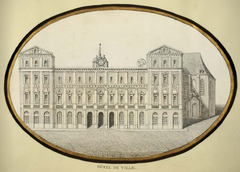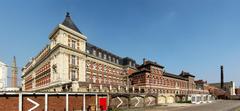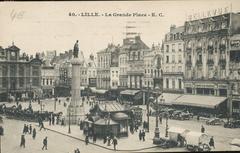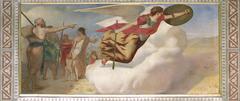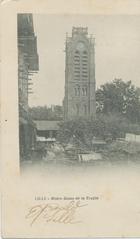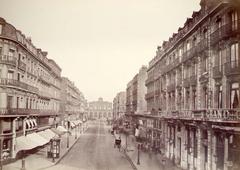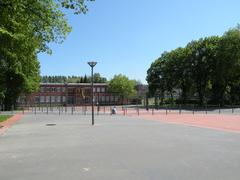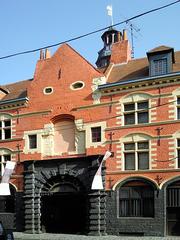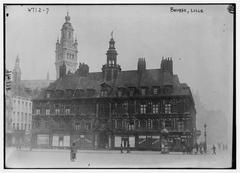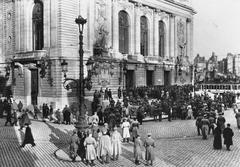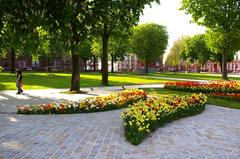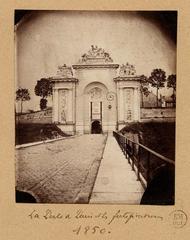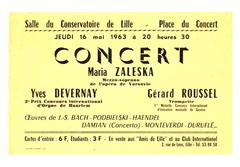
Comprehensive Guide to Visiting Palais Rihour, Lille, France
Date: 19/07/2024
Introduction
Nestled in the heart of Lille, France, the Palais Rihour stands as a magnificent testament to Gothic architecture and European history. Constructed in the 15th century under the auspices of Philip the Good, Duke of Burgundy, this palace is both a cultural landmark and a symbol of the region’s rich heritage. Visitors are drawn to its intricate stone carvings, pointed arches, and ribbed vaults, all of which encapsulate the grandeur of the Burgundian era. The Palais Rihour is not only a relic of the past but also a living part of Lille’s vibrant cultural tapestry, housing the Lille Tourist Office and hosting various cultural events year-round. Whether you’re intrigued by its historical significance, architectural beauty, or contemporary relevance, this guide aims to provide comprehensive insights into visiting Palais Rihour, from its origins and architectural features to practical visitor information and nearby attractions. For more detailed information, you can visit the official Lille Tourism website.
Table of Contents
- Introduction
- Origins and Construction
- Architectural Features
- Historical Events
- Decline and Restoration
- Modern Significance
- Visitor Information
- Travel Tips
- FAQ
- Conclusion
Origins and Construction
The Palais Rihour, located in Lille, France, is a significant historical monument dating back to the 15th century. Its construction began in 1453 under the direction of Philip the Good, Duke of Burgundy. The palace was intended to serve as a residence for the dukes of Burgundy and a symbol of their power and influence in the region. The architectural style of the palace is predominantly Gothic, reflecting the design trends of the period. The construction was completed in 1473, making it one of the most important buildings of its time in Lille.
Architectural Features
Gothic Influence
The Palais Rihour is a prime example of Gothic architecture, a style that flourished in Europe during the High and Late Middle Ages. The Gothic influence is evident in the building’s pointed arches, ribbed vaults, and flying buttresses. Intricate stone carvings and stained glass windows further highlight the Gothic elements, adding both aesthetic appeal and functional benefits such as structural support and natural lighting.
The Chapel
One of the most striking features of the Palais Rihour is its chapel, which exemplifies the grandeur of Gothic architecture. The chapel’s vaulted ceilings are adorned with intricate ribbing, creating a sense of height and space. The stained glass windows depict various religious scenes and illuminate the interior with colorful light, creating a serene atmosphere. The chapel’s altar, with its detailed carvings and ornate decorations, showcases the artistic and architectural prowess of the time.
The Guard Room
The Guard Room, or “Salle des Gardes,” was originally used by the palace guards and is characterized by its large, open space and high ceilings. The room’s design reflects the Gothic style, with pointed arches and ribbed vaults creating a sense of grandeur. The stone walls are adorned with tapestries and other decorative elements, and a large fireplace provides essential heating during colder months.
The Grand Hall
The Grand Hall, or “Salle du Conclave,” was used for important meetings and gatherings. This expansive hall features vaulted ceilings and pointed arches typical of Gothic architecture, along with detailed stone carvings and decorative elements. Large windows allow natural light to flood the space, creating a bright and airy atmosphere.
The Tower
The Palais Rihour features a prominent tower with a pointed spire and intricate stonework, a quintessential example of Gothic architecture. The tower serves both aesthetic and functional purposes, offering a vantage point to survey the surrounding area and providing defensive capabilities with narrow windows and thick walls.
Historical Events
Throughout its history, the Palais Rihour has been the site of numerous significant events. During the 16th century, the palace played a crucial role in the political and social life of Lille. It was here that important decisions were made, and grand ceremonies were held. In 1667, the palace witnessed the signing of the Treaty of Lille, which marked the end of the War of Devolution between France and Spain. This treaty had a profound impact on the political landscape of Europe and solidified Lille’s strategic importance.
Decline and Restoration
The Palais Rihour experienced a period of decline in the 18th century. The palace suffered extensive damage during the French Revolution, and many of its original features were lost. However, efforts to restore the palace began in the 19th century. The restoration work aimed to preserve the historical and architectural integrity of the building while making it accessible to the public. Today, the Palais Rihour stands as a testament to the rich history and cultural heritage of Lille.
Modern Significance
In contemporary times, the Palais Rihour serves as a cultural and administrative center. It houses the Lille Tourist Office, making it a starting point for visitors exploring the city. The palace also hosts various cultural events, exhibitions, and ceremonies, contributing to the vibrant cultural scene of Lille. Its historical significance and architectural beauty continue to attract tourists and history enthusiasts from around the world.
Visitor Information
Visiting Hours and Tickets
Palais Rihour is open to visitors from Monday to Saturday, 9 AM to 6 PM. It is closed on Sundays and public holidays. Admission is free, although certain special exhibitions or events may require a ticket purchase.
Guided Tours
To fully appreciate the historical and architectural significance of Palais Rihour, consider joining a guided tour. These tours are available in multiple languages, including English, French, and Spanish. Guided tours provide in-depth insights into the palace’s history, its Gothic architecture, and its role in Lille’s cultural heritage. Booking in advance is recommended, especially during peak tourist seasons. Information on guided tours can be found on the official Palais Rihour page.
Accessibility
Palais Rihour is committed to being accessible to all visitors. The main entrance is equipped with ramps, and there are elevators available for accessing different floors of the palace. Wheelchair-accessible restrooms are also available on-site. Visitors with specific accessibility needs are encouraged to contact the palace in advance to ensure a smooth visit. More details on accessibility can be found here.
Photography and Filming
Photography is generally allowed within Palais Rihour, but the use of flash and tripods is often restricted to protect the delicate interiors and artworks. For those interested in filming or professional photography, special permissions may be required. It is advisable to check the specific guidelines on the Palais Rihour photography policy page.
Travel Tips
Nearby Attractions
Palais Rihour is centrally located in Lille, making it an excellent starting point for exploring other nearby attractions. Just a short walk away is the Grand Place, Lille’s main square, known for its vibrant atmosphere and stunning architecture. The Old Stock Exchange (Vieille Bourse) and the Opera House are also within walking distance. For art enthusiasts, the Palais des Beaux-Arts, one of the largest art museums in France, is a must-visit. More information on nearby attractions can be found on the Lille Tourism website.
Dining Options
After exploring Palais Rihour, visitors can enjoy a variety of dining options in the surrounding area. From traditional French bistros to international cuisine, there is something to suit every palate. For a taste of local specialties, try a Flemish carbonnade or a potjevleesch at one of the nearby restaurants. For recommendations and reviews, check out TripAdvisor’s Lille dining guide.
Shopping
Lille is known for its vibrant shopping scene, and the area around Palais Rihour is no exception. Visitors can explore a mix of high-end boutiques, local artisan shops, and bustling markets. The Euralille shopping center, located just a short distance from the palace, offers a wide range of stores and dining options. For those interested in unique souvenirs, the Wazemmes Market is a great place to find local crafts and delicacies. More shopping information can be found here.
Safety Tips
While Lille is generally a safe city, it is always wise to take standard precautions. Keep an eye on personal belongings, especially in crowded areas, and be aware of your surroundings. The local police and tourist information centers are available to assist visitors with any concerns. For emergency services, dial 112. For more safety tips, visit the Lille safety guide.
Seasonal Events
Palais Rihour often hosts a variety of seasonal events, including art exhibitions, historical reenactments, and cultural festivals. These events provide a unique opportunity to experience the palace in a different light and learn more about Lille’s rich cultural heritage. Check the events calendar for upcoming events during your visit.
Souvenirs and Gift Shops
Before leaving Palais Rihour, be sure to visit the on-site gift shop. Here, you can find a range of souvenirs, including postcards, books, and locally made crafts. These items make for perfect mementos of your visit or gifts for friends and family. For more information on available souvenirs, visit the Palais Rihour gift shop page.
Language Tips
While French is the primary language spoken in Lille, many locals, especially those working in the tourism industry, speak English. However, learning a few basic French phrases can enhance your experience and is often appreciated by locals. For language tips and common phrases, check out this French language guide.
FAQ
Q - What are the Palais Rihour’s visiting hours?
A - The Palais Rihour is open from Monday to Saturday, 9 AM to 6 PM.
Q - Do I need to buy tickets to enter the Palais Rihour?
A - Admission is free, but some special exhibitions may require a ticket purchase.
Q - Is the Palais Rihour accessible for visitors with mobility issues?
A - Yes, the Palais Rihour has ramps and elevators to accommodate visitors with disabilities.
Q - What other attractions are nearby?
A - Nearby attractions include the Lille Citadel and the Old Stock Exchange.
Q - Can I take photos inside Palais Rihour?
A - Photography is generally allowed, but the use of flash and tripods is often restricted.
Conclusion
The Palais Rihour in Lille, France, is more than just an architectural marvel; it is a living museum that offers a window into the past while serving contemporary cultural needs. From its origins in the 15th century under Duke Philip the Good to its role in modern-day Lille as a cultural and administrative hub, the palace embodies the historical and cultural richness of the region. Visitors can explore its Gothic splendor, learn about its significant historical events, and enjoy the various amenities and nearby attractions. Whether you’re a history buff, an architecture enthusiast, or simply looking for a unique travel experience, Palais Rihour offers something for everyone. Don’t miss out on this historical treasure the next time you’re in Lille. For up-to-date information on visiting hours, ticket prices, and special events, visit the Palais Rihour official page.
References
- Palais Rihour. (n.d.). Retrieved from Lille Tourism
- History of Palais Rihour. (n.d.). Retrieved from French Moments
- Architectural Heritage of Lille. (n.d.). Retrieved from Architectural Digest
